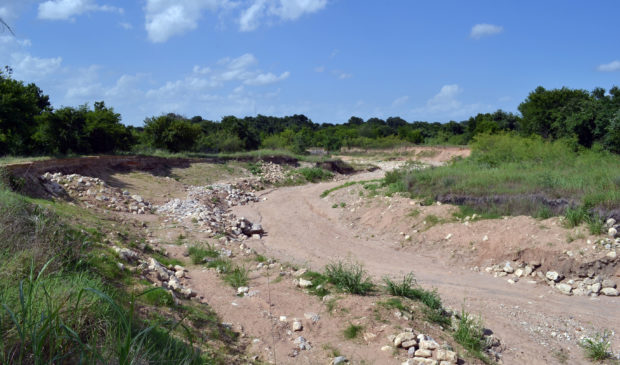FEMA grants Austin funding to help fix Guerrero Park
Monday, February 26, 2018 by
Jessi Devenyns Eight months ago, Austin’s Watershed Protection Department optimistically declared that the washed-out bridge over what’s known as Country Club Creek West in Roy G. Guerrero Colorado River Park would be completed by 2020. Unfortunately, now the plan has been shifted back to 2021.
In an update to the Environmental Commission on Feb. 21, Janna Renfro, an engineer with the Watershed Protection Department, explained that the channel stabilization project, which includes the construction of a new creek crossing, would begin in 2020 and will continue through 2021. The funding, however, will not be a problem.
The project will stabilize 2,000 linear feet of channel and is expected to cost $13 million. Already, the department has identified $5.5 million for the project, while the Parks and Recreation Department has indicated it can contribute $2.5 million. To fill the funding gap, Renfro said that the city applied for an $8.5 million grant from the Federal Emergency Management Agency reimbursement program, which was recently approved at the federal level. She explained that an approval letter is expected soon.
Commissioner Pam Thompson congratulated staff on securing federal funding. “I’m not sure what the city would do if FEMA funding wasn’t available, and I was really glad to hear that you expect it,” she said.
Although the project completion date has been extended, the Watershed Protection Department has already taken measures to stave off further damage to the park.
“Doing nothing is not an option here,” said Renfro. “This is not a problem that is going to solve itself.” Indeed, according to her, every 1-inch rain event that Austin experiences moves the erosion 20 or 30 feet.
In an effort to halt the progress of the erosion, in May 2017, the Watershed Protection Department constructed a barrier to protect the baseball fields located on the eastern edge of Guerrero Park. More recently, the department stabilized the leading edge of the erosion this month by barricading it with 2,700 tons of rocks.
“It is a temporary solution that we hope will hold the line,” explained Renfro. She noted that if the city had done nothing, the erosion would quickly begin to threaten city infrastructure and the private properties that surround the park.
The washed-out bridge that collapsed during the two federally declared flooding disasters of 2015 was a critical piece along a trail that connected the Ann and Roy Butler Hike-and-Bike Trail to the baseball fields and disc golf course in the eastern half of the park, the Austin Community College Riverside Campus, and the Montopolis neighborhood. Without it, those who wish to cross have had to take a 3-mile detour.
Recognizing the impracticality of this solution, Renfro said that the department has “also looked at an upstream crossing” to use as a temporary solution before the permanent replacement bridge is built. The upstream crossing will be an 8-foot sidewalk with connectivity between the eastern and western banks.
Although it is not ideal, the crossing is at “the very edge of the parkland before you start getting into private property,” said Renfro. “We just wanted to provide something that wasn’t a muddy path.”
The Public Works Department’s Urban Trails Program has already identified the funding for this provisional project.
Gordon Maxim-Kelley, the president of the Waterloo Disc Golf Club, explained that formalizing the proposed crossing could be dangerous for passersby because it goes directly through the disc golf course. It’s “like walking through a soccer field during a game. It’s just not a good idea,” he said.
Maxim-Kelley continued that he has spoken with the parks department and that his impression is that it not in favor of the crossing either. However, as it stands there is not an easy solution. According to him, people “scoff” at having to go to take a detour over to Riverside.
Renfro explained that the Watershed Protection Department expects to have the design phase 60 percent complete by summer, at which point it will ask for public input on the project.
“We want to be able to do as much as we can to incorporate the needs of the public,” she said. However, she noted that the department will have to balance public opinion with stringent engineering requirements. “There is no way to understate the complexity of the engineering design here,” she said.
Photo by Caleb Pritchard.
The Austin Monitor’s work is made possible by donations from the community. Though our reporting covers donors from time to time, we are careful to keep business and editorial efforts separate while maintaining transparency. A complete list of donors is available here, and our code of ethics is explained here.
You're a community leader
And we’re honored you look to us for serious, in-depth news. You know a strong community needs local and dedicated watchdog reporting. We’re here for you and that won’t change. Now will you take the powerful next step and support our nonprofit news organization?










